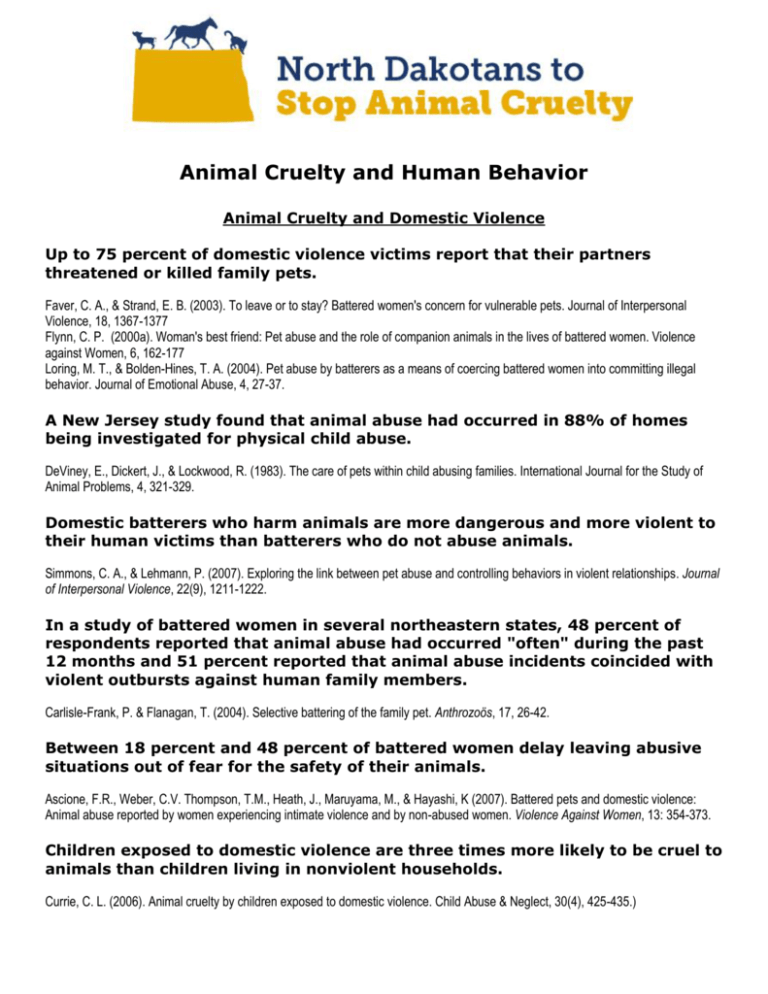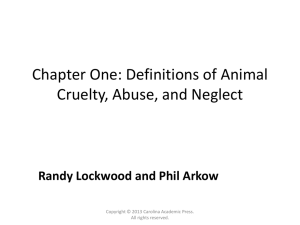Animal Cruelty and Human Behavior
advertisement

Animal Cruelty and Human Behavior Animal Cruelty and Domestic Violence Up to 75 percent of domestic violence victims report that their partners threatened or killed family pets. Faver, C. A., & Strand, E. B. (2003). To leave or to stay? Battered women's concern for vulnerable pets. Journal of Interpersonal Violence, 18, 1367-1377 Flynn, C. P. (2000a). Woman's best friend: Pet abuse and the role of companion animals in the lives of battered women. Violence against Women, 6, 162-177 Loring, M. T., & Bolden-Hines, T. A. (2004). Pet abuse by batterers as a means of coercing battered women into committing illegal behavior. Journal of Emotional Abuse, 4, 27-37. A New Jersey study found that animal abuse had occurred in 88% of homes being investigated for physical child abuse. DeViney, E., Dickert, J., & Lockwood, R. (1983). The care of pets within child abusing families. International Journal for the Study of Animal Problems, 4, 321-329. Domestic batterers who harm animals are more dangerous and more violent to their human victims than batterers who do not abuse animals. Simmons, C. A., & Lehmann, P. (2007). Exploring the link between pet abuse and controlling behaviors in violent relationships. Journal of Interpersonal Violence, 22(9), 1211-1222. In a study of battered women in several northeastern states, 48 percent of respondents reported that animal abuse had occurred "often" during the past 12 months and 51 percent reported that animal abuse incidents coincided with violent outbursts against human family members. Carlisle-Frank, P. & Flanagan, T. (2004). Selective battering of the family pet. Anthrozoös, 17, 26-42. Between 18 percent and 48 percent of battered women delay leaving abusive situations out of fear for the safety of their animals. Ascione, F.R., Weber, C.V. Thompson, T.M., Heath, J., Maruyama, M., & Hayashi, K (2007). Battered pets and domestic violence: Animal abuse reported by women experiencing intimate violence and by non-abused women. Violence Against Women, 13: 354-373. Children exposed to domestic violence are three times more likely to be cruel to animals than children living in nonviolent households. Currie, C. L. (2006). Animal cruelty by children exposed to domestic violence. Child Abuse & Neglect, 30(4), 425-435.) Approximately 60 percent of college students who witnessed or perpetrated animal cruelty as children also reported experiences with child mistreatment or domestic violence. DeGue, S. & DiLillo, D. (2009). Is Animal Cruelty a “Red Flag” for Family Violence? Investigating Co-Occurring Violence Toward Children, Partners, and Pets. Journal of Interpersonal Violence, Vol. 24, No. 6, 1036-1056 Animal Cruelty and Mass Murderers/Serial Killers Serial killers including Jeffrey Dahmer, Ted Bundy, and David Berkowitz each tortured and/or killed animals as children. Muscari, M. (2004). Juvenile animal abuse: Practice and policy implications for PNPs. Journal of Pediatric Health Care 18 (1), 15 – 21. The largest single survey to date of serial killers found; 36 percent admitted to committing animal cruelty as children; 46 percent admitted to committing animal cruelty as adolescents; 36 percent admitted to committing animal cruelty as adults. Ressler, R., Burgess, A., & Douglas, J. (1988). Sexual homicides: Patterns and motives. Lexington, MA: Lexington Books. A 2003 study found that of 354 serial killers profiled, 21 percent were known to have committed animal cruelty, although it is speculated that more might have committed unreported incidents of animal cruelty Wright, J. & Hensley, C. (2003). From Animal Cruelty to Serial Murder: Applying the Graduation Hypothesis. International Journal of Offender Therapy and Comparative Criminology 47(1), 71-88. The 2003 Wright & Hensley study also looked at five serial killers in depth (Carroll Edward Cole, Jeffery Dahmer, Edmund Kemper, Henry Lee Lucas, and Arthur Shawcross), and found that each killer turned to animals to revenge their rage and humiliation. The persons who caused the frustration were seen as too powerful to hurt, so they chose animals because they were viewed as weak and vulnerable, to later repeat the patterns of their animal cruelty against human victims. (Wright, J. & Hensley, C. (2003). From Animal Cruelty to Serial Murder: Applying the Graduation Hypothesis. International Journal of Offender Therapy and Comparative Criminology 47(1), 71-88.) Of the nine school shootings between 1996 and 1999, half of the shooters had histories of animal cruelty. (Verlinden, S., Herson, M., & Thomas, J. (2000). Risk factors in school shootings. Clinical Psychology Review 29 (1), 3-56.) Animal Cruelty and Other Serious Crime The Chicago Police Department examined the arrest records of 332 people who they had arrested for animal cruelty, and found that: 70% 86% 70% 65% 27% 13% 59% of suspects had arrests for other felonies, including two homicides; had multiple arrests; had narcotics arrests of which 68% were for sales or trafficking; were arrested for battery-related violent offenses; for firearms violations; for sex crimes; and were gang members. Chicago Police Department (2008). Statistical Summary of Offenders Charged with Crimes against Companion Animals, July 2001-July 2004. Chicago Police Department, Chicago, IL. A Massachusetts study of 153 animal abusers found that 70% were arrested for other crimes within 10 years of their animal cruelty arrest: 38% 44% 37% 37% for for for for violent crimes; property crimes; drug offenses; and disorder offenses. Arluke, A,. & Luke, C. (1997). Physical cruelty toward animals in Massachusetts, 1975-1996. Society and Animals 5(3), 195204. A Canadian Police study found that 70% of people arrested for animal cruelty had other violent crimes, including homicide, in their records. (Boat, B. W., & Knight, J. C. (2000). Experiences and needs of adult protective services case managers when assisting clients who have companion animals. Journal of Elder Abuse & Neglect 12(3/4), 145-155.) North Dakotans to Stop Animal Cruelty P.O. Box 5376, Fargo, ND 58105 www.NDStopCruelty.com Paid for by North Dakotans to Stop Animal Cruelty, Karen Thunshelle, Chairman







